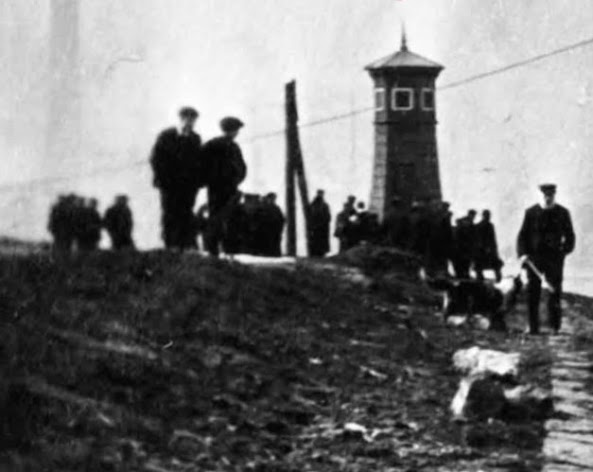The 1912 lighthouses of Belfast harbour
On the morning of April 2nd, 1912, the ship groaned inwardly and eased out from the fitting-out jetty, as the crowd cheered excitedly.
Gazing
at the delirious scenes ashore, Able Seaman Charlie Dumigan’s 45-year-old hands
lightly rested on the handrail, and his thoughts strayed back to the Ailsa
Craig and the deafening lack of fuss whenever she sailed. There was
much to be said for coastal steamers, he thought. Far less hullabaloo and
watching your language. At least, they were only delivering this girl to
Southampton and then they’d be back home to Portaferry, while she sailed the
world for many years.
Escorted
by four tugboats, the ship approached a curious wooden structure on the
quayside, maybe twenty-five feet tall and bearing a resemblance to a Chinese
pagoda. Fortunately for this semi-factual account, Charlie Dumigan was a
lighthouse enthusiast and recognised the East Twin Light immediately.
The
lighthouse dated back to the first tentative steps of the Belfast Harbour
Commissioners in their attempts to transform the swamp that imprisoned Belfast
into a manageable and accessible port. As
the first dredgers scooped out centuries of mud and silt, they deposited it in
a thin line along the centre of the channel. Soon, this silt became a long
Chile-shaped island and a lighthouse was placed at either end. As the buzz around
land reclamation intensified, the island grew and soon lost its insular status.
‘This is the spot where they will place the Mew Island Optic a hundred years from
now,’ mused Charlie, who was also a bit of a clairvoyant on the side.
Belfast Lough lighthouse featuring on a 1930s tourism poster
Purring
along the quayside, the ship passed the two triangular lights on either side of
the entrance of the Victoria Channel: one at the end of West Twin Island, the other
at the end of the East Twin. Both had been erected when the New Straight
Channel had been developed in the 1890s and both showed green lights, though
Charlie knew that would doubtless change in the future. The three West lights
were on a pole but the East Twin lights were affixed to the house at the end of
the peninsula, wherein the keeper John Harrison and his wife Elizabeth resided.
There
were three pile lights, about a mile apart, leading out of the port and into Belfast
Lough, but these were unwatched and automatic. Each had once had resident
keepers when constructed in 1891 but, when two of them were ploughed into (with,
incredibly, only two fatalities), the keepers were withdrawn and smaller,
light-only structures were erected.
Out
in the centre of the lough, the liner passed the outermost pile light called,
with great imagination, Belfast Lough lighthouse. Many people called it
Mitchell’s lighthouse, after the blind Belfast engineer, Alexander Mitchell,
but in fact Mitchell’s original 1844 pile light had been located opposite
Holywood before being knocked off its pins by a rampaging Earl of Ulster
(the Fleetwood paddle-steamer, not a belligerent member of the aristocracy) in
1889.
Fortunately,
for this narration, at this point, our hardened and gnarled old sailor quickly
moved to the front of the ship, where he belted out ‘My heart will go on,’
whilst taking in the two relatively new lighthouses at the north and south
entrances to the lough itself.
Blackhead county Antrim c.1907. Commissioner of Irish Lights collection in the National Library
On
the port side, Blackhead lighthouse, only ten years old, sat up on her perch on
the cliff face, staring boyishly at the passing liner. Charlie smiled wistfully
as he remembered that his grandson, Billy Dumigan, would one day serve at this
light.
Above
it loomed the grey bulk of Muldersleigh Hill, where Sir Robert Reading had
constructed the first state-sponsored lighthouse in Ulster way back in 1667. Unfortunately,
it had only lasted a few years, as Bob was more interested in collecting dues
from passing ships than maintaining this (and his five other) lights.
On
the starboard side as they left Belfast Lough, Charlie noticed the tall, black
tower of Mew Island. “It will look even better when it gets its white band
in 1954,” he mused. Mew Island was the outermost of the Copeland Islands. A
light, the ruins of which Charlie could just discern, had been established on
the middle Copeland Island – coincidentally called Lighthouse Island – in
either 1715 or 1735, depending on which book you read. This, like Muldersleigh
Hill, had been a coal-burning, cottage-type light, until decent towers were built
in 1790 and then 1820. It was only then that people started wondering why ships
were still being wrecked on Mew Island and maybe the light was on the wrong
island, despite the name. With the lighthouse authority’s characteristic speed
of action, the Mew Island lighthouse eventually shone forth sixty-four years,
and many wrecks, later.
The black lighthouse at Mew Island. Charlie found it hard to imagine it with a white band.
“Dumigan!
Stop pfaffing about and do some work!” yelled a
familiar voice. Charlie sighed and hopped to it as the ship began manoeuvres.
Later that night, he might spot the elegant white tower at Donaghadee and then
tip his cap to the Skulmartin and South Rock lightvessels. He well knew, another
grandson – also named Charles – would serve as Master on the South Rock many years hence.
The LV Petrel on the South Rock light station c.1907 Commissioner of Irish Lights collection in the National Gallery
As
he set about his work, he idly wondered how many lighthouses the ship would
pass after he left her at Southampton. “Not many, actually” his inner
voice answered.
Boat passing the East Twin lighthouse 2nd April 1912. One of the figures near the bow may have been Charlie Dumigan. (From the John Kempster album, courtesy Senan Molony)








Comments
Post a Comment